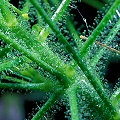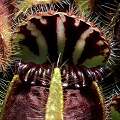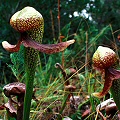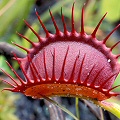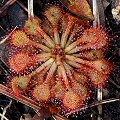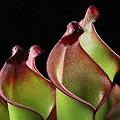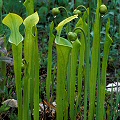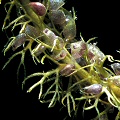| Cephalotus 'Bananito' |
Carniv.Pl.Newslett.45:77 (2016)
Details |
CP Photofinder |
Cultivar: Cephalotus 'Bananito' E.Piacenti
Publication: Carniv.Pl.Newslett.45:77 (2016)
Synonym: =Cephalotus follicularis Labill.
Originator: E.Piacenti, Bologna, IT, 2012
Nominant: E.Piacenti, 3. 4. 2014
Registrant: E.Piacenti, 11. 4. 2016
Horicultural comment: Registered 30. 11. 2016 {JS}
Standard: Carniv.Pl.Newslett.45:77 (2016)
Propagation: vegetative
Etymology: Italian for “small bananaâ€
Description: Carniv.Pl.Newslett.45:77 (2016)
"In general, Cephalotus follicularis Labill. plants are very similar to each other, but one of these plants produced an unmistakable elongated shape, like a banana (Fig. 7). (...) This plant is very vigorous. The pitchers have maintained their characteristic shape while being grown both indoor and outside."
|
| Cephalotus 'Clayton's T Rex' |
Carniv.Pl.Newslett.42:145 (2013)
Details |
CP Photofinder |
Cultivar: Cephalotus 'Clayton's T Rex' C.Clayton
Publication: Carniv.Pl.Newslett.42:145 (2013)
Synonym: =Cephalotus follicularis Labill.
Originator: C.Clayton, Triffid Park, AU, 2007
Nominant: C.Clayton, 2007
Registrant: C.Clayton, 12. 6. 2013
Horicultural comment: Registered 26. 12. 2013 {JS}
Standard: Carniv.Pl.Newslett.42:145, fig.1 (2013)
Propagation: vegetative
Etymology: after breeder and because it is the "undisputed king" of the teratological leaved [Cephalotus follicularis {Labill.}].
Description: Carniv.Pl.Newslett.42:145 (2013)
"Cephalotus ' Clayton's T Rex ' C.Clayton is the cultivar with the largest and rarest of all the teratological traps, up to 5 cm long and 5 cm deep (Fig. 1). These grow horizontal, out from the crown, and their most distinguishing feature is the reverse or 45deg backward sloping pitcher. Rather than having a lid, it has what can only be described as horns; these seldom open however. Teratological traps are produced along with the normal carnivorous traps. However, when grown commercially, under controlled conditions at Triffid Park, these will grow at any time of the year. At the time of writing, it is not known if the teratological leaves/traps are carnivorous or not. They are long lasting, and will persist for 12 months or more. The clone is stable in cultivation, but only produces teratological traps rarely. Propagation is by any of the standard vegetative techniques used for Cephalotus follicularis Labill. including tissue culture."
|
| Cephalotus 'Donna's Destiny' |
Cephalotus Teratol.Abnorm.L.:21 (2011)
Details |
CP Photofinder |
Cultivar: Cephalotus 'Donna's Destiny' C.Clayton
Publication: Cephalotus Teratol.Abnorm.L.:21 (2011)
Synonym: =Cephalotus follicularis Labill.
Originator: C.Clayton, Triffid Park, AU, 2007
Nominant: C.Clayton, 2007
Registrant: C.Clayton, 29. 5. 2007
Horicultural comment: Registered 11. 6. 2013 {JS}
Standard: Cephalotus Teratol.Abnorm.L.:21 (2011)
Propagation: vegetative
Etymology: after originator's daughter
Description: Cephalotus Teratol.Abnorm.L.:21 (2011)
"Cephalotus ' Donna's Destiny ' C.Clayton (teratology) has an upright, open-ended, two horned, one keeled trap, which always faces out from the plant's crown. It is totally different from the normal Cephalotus follicularis Labill. carnivorous traps, or the non-carnivorous leaves.
The Cephalotus ' Donna's Destiny ' C.Clayton (teratological) traps are produced after the seasonal growing ofthe non-carnivorous leaves, and before the carnivorous traps. However, when grown commercially, under controlled conditions at Triffid Park, these will grow at any time of the year.
At the time of writing, it is not known if the Cephalotus ' Donna's Destiny ' C.Clayton (teratological) leaves/traps are carnivorous or not. Cephalotus ' Donna's Destiny ' C.Clayton (teratological) traps only ever grow to a maximum of half the length of non-carnivorous leaves. They are long lasting, and will persist for 12 months or more. (...) They (i.e. the cultivar's clones) are stable in cultivation, and produce (teratological) traps readily. Propagation is by any of the standard vegetative techniques used for Cephalotus follicularis Labill. including tissue culture."
|
| Cephalotus 'Dudley Watts' |
Pl.Carniv.35(2):42 (2014)
Details |
CP Photofinder |
Cultivar: Cephalotus 'Dudley Watts' S.Morley
Publication: Pl.Carniv.35(2):42 (2014)
Synonym: =Cephalotus follicularis Labill.
Originator: D.Watts, UK, late 1980s
Nominant: S.Morley, Fangfoss, UK, 2013
Registrant: S.Morley, 2013
Horicultural comment: Registered 24. 1. 2014 {JS}
Standard: Pl.Carniv.35(2):43 (fig.1) (2014)
Propagation: vegetative via leaf or rhizome cuttings or by division
Etymology: after originator
Description: Pl.Carniv.35(2):42 (2014)
"The notable characteristics of this cultivar are the large, dark coloured pitchers and a chunky, thickened, "oversized" peristome; I measured the percentage of the total height of the pitcher occupied by the peristome on a Cephalotus ' Dudley Watts ' S.Morley pitcher, which is 17% of its height, whilst on a more typical plant it is 14%. The pitchers of large specimens of Cephalotus ' Dudley Watts ' S.Morley are slightly constricted towards the mouth and have a pronounced crinkled appearance at the front. See Figure 1. The pitcher I measured for reference for this description is 59mm high, which contrasts with a more typical-sized plant at only 35mm. See Figure 2. I have previously estimated the colour according to the RHS mini colour chart as corresponding to RHS 187A (dark purple brown), although colour will vary depending upon growing conditions.
The plant is slightly easier to grow than most other Cephalotus Labill. due to its vigour. It takes well from leaf cuttings and matures quickly. This cultivar requires good light to produce optimum colouration and all my plants are grown in a cool greenhouse, receiving full sun all day with no shading, apart from bubble plastic, with temperatures in the range of 5-35 degC. I grow my pitants in a mixture of approximately 1:1 peat substitute : perlite in relatively deep rose pots for mature plants."
|
| Cephalotus 'Eden Black' |
Carniv.Pl.Soc.J.(UK) 29:7 (2007)
Details |
CP Photofinder |
Cultivar: Cephalotus 'Eden Black' S.Morley
Publication: Carniv.Pl.Soc.J.(UK) 29:7 (2007)
Synonym: =Cephalotus follicularis Labill.
Originator: S.Morley, Fangfoss, York, UK, late 1980s
Nominant: S.Morley
Registrant: S.Morley, 6. 1. 2007
Horicultural comment: Registered 29. 7. 2007 {JS}
Standard: Carniv.Pl.J.(UK)29:8, fig.1 (2007)
Propagation: vegetatively via leaf or rhizome cuttings or by division
Etymology: after originator's house name and pitcher colour
Description: Carniv.Pl.Soc.J.(UK) 29:7 (2007)
"The most notable characteristic of this cultivar is the darkly coloured pitchers. I refer to them as black, which is possibly what some might call artistic licence, but but they are certainly as black as many darkly coloured plants of popular garden plant species given the same description; they are probably best described as dark purple. I find it almost impossible to capture accurately the colour in any photograph, although photos give an impression of the colour, hence I will refer to colour using standard colours from the RHS colour chart. To be specific they correspond to the RHS mini colour chart colour RHS 200A (dark brown) when fully coloured. See Figure 1 which shows a fully coloured pitcher. In contrast my "Dudley Watts" clone has pitcher colour corresponding to RHS 187A (dark purple brown). The peristome of Cephalotus 'Eden Black ' S.Morley darkens quickly in full sun and the rest of the pitcher follows suit, with the pitcher eventually assuming virtually the same colour as the peristome; this is unlike any other Cephalotus Labill. I grow, where the pitchers are usually a hue lighter than the peristome. The dark colour spreads to both the outer and inner surfaces of the lid, even suffusing the windows with colour. The inner collar of the pitcher also becomes a dull purple colour in parts. The pitchers are on the large side, and are at least as big as my "Dudley Watts" pitchers at 5 cm, although they are getting bigger every year; the plant produced flower buds in 2005 for the first time, but is possibly not yet fully mature. The pitchers are elegant, long, relatively smooth and more-or-less straight-sided, lacking very crinkly pitchers characterising some of the clones available in cultivation. They have a well-formed peristome and a wide mouth; here they differ from the "Dudley Watts" clone which is noticeably constricted towards the mouth with a chunky, thickened peristome. The plant is rather shy in producing non-carnivorous leaves, a trait it shares with my "vigorous clumping" clone, which is a super characteristic for the grower but not terribly conductive to propagation from leaf cuttings (non-carnivorous leaves are usually easier to root)!"
|
| Cephalotus 'Elizabeth' |
Carniv.Pl.Newslett.47:126 (2018)
Details |
CP Photofinder |
Cultivar: Cephalotus 'Elizabeth' C.Toole
Publication: Carniv.Pl.Newslett.47:126 (2018)
Synonym: =Cephalotus follicularis Labill.
Originator: C.Toole, Oregon City, Ore., US, 12. 2011
Nominant: C.Toole
Registrant: C.Toole, 31. 5. 2018
Horicultural comment: Registered 29. 9. 2018 {JS}
Standard: Carniv.Pl.Newslett.47:126 (fig. 2) (2018)
Propagation: vegetative
Description: Carniv.Pl.Newslett.47:126 (2018)
"Cephalotus ' Elizabeth ' C.Toole has absolutely been a true joy for me to grow since I received it in December of 2011. It was originally selected for its overly defined peristome, as well as for being rather hairy. However, after sharing the plant with other carnivorous plant hobbyists here in Oregon, an even more captivating feature was brought to my attention. Instead of having the normal lid of a typical Cephalotus pitcher which curves downward towards the peristome, the lid of Cephalotus ' Elizabeth ' C.Toole stands completely upright (Fig. 2). In doing so, the lid flattens out and slightly splits to a notch in the middle to accommodate for the stretch. The average adult pitcher size is about 5 cm excluding the added height of the lid. Including the lid, adult pitchers reach 7 cm. In strong lighting, Cephalotus ' Elizabeth ' C.Toole produces alluring, dark pitchers. It does not produce many non-carnivorous leaves in my experience, however C. ‘Elizabeth’ is propagated just as easily by pitcher pullings. (...) For me, Cephalotus ' Elizabeth ' C.Toole happily grows under a set of T5 HO lights 12-15 hours a day with an average temperature of between 21-24 deg C."
|
| Cephalotus 'Hummer's Giant' |
Carniv.Pl.Newslett.29:119 (2000)
Details |
CP Photofinder |
Cultivar: Cephalotus 'Hummer's Giant' J.Hummer
Publication: Carniv.Pl.Newslett.29:119 (2000) https://legacy.carnivorousplants.org/cpn/articles/CPNv29n4p116_122.pdf
Web Publication: https://legacy.carnivorousplants.org/cpn/Species/v29n4p116_122.html#hummers
Synonym: =Cephalotus follicularis Labill.
Originator: J.Hummer, Arlington, VA, USA, 9. 1986
Nominant: J.Hummer, 3. 4. 2000
Registrant: J.Hummer, 10. 5. 2000
Horicultural comment: Registered 29. 1. 2001 {JS}
Standard: Carniv.Pl.Newslett.29:120 (2000)
Propagation: vegetative only
Etymology: after originator and size of the plants
Description: Carniv.Pl.Newslett.29:119 (2000)
"This particular clone produces pitcher leaves up to 6 (-8) cm (2.5-3 inches) in length and about 2.5 cm (1 inch) in width. It usually takes about three years for plantlets grown from leaf cuttings to reach maturity and full size. (...) Since at maturity this clone reaches much larger sizes than normal Cephalotus Labill. plants in cultivation, I am establishing it as a cultivar (...)."
|
| Cephalotus 'Jason's Arks' |
Cephalotus Teratol.Abnorm.L.:23 (2011)
Details |
CP Photofinder |
Cultivar: Cephalotus 'Jason's Arks' C.Clayton
Publication: Cephalotus Teratol.Abnorm.L.:23 (2011)
Synonym: =Cephalotus follicularis Labill.
Originator: C.Clayton, Triffid Park, AU, 2007
Nominant: C.Clayton, 2007
Registrant: C.Clayton, 29. 5. 2007
Horicultural comment: Registered 11. 6. 2013 {JS}
Standard: Cephalotus Teratol.Abnorm.L.:23 (2011)
Propagation: vegetative
Etymology: after originator's boat-loving son-in-law
Description: Cephalotus Teratol.Abnorm.L.:23 (2011)
"Cephalotus ' Jason's Arks ' C.Clayton (teratologies) are small, boat shaped, horizontal shaped leaves or traps; the depression always facing upwards. These leaves/traps don't appear to be fixed, but are variable. Some have a simple depression in the upper leaf surface. However, there appears to be a full spectrum of leaf shapes with others terminating in a quite deep complex trap. Yes a trap. One glance at a range of these leaves/traps, and there before you, eons of evolution. One mystery remains - why are they so small? We can only speculate that this tiny size was what Cephalotus follicularis Labill. ancestors looked like, before they became fully carnivorous and giganticized with their new nutrient rich diet. One thing that all these leaves/traps have in common, is that they are small, 1 or 2cm long. (...) The (teratological) leaves/traps are long lasting and will persist for 12 months or more. They are stable in cultivation and readily produce Cephalotus ' Jason's Arks ' C.Clayton (teratological) leaves/traps. Propagation is by any of the standard vegetative techniques used for Cephalotus follicularis Labill. including tissue culture."
|
| Cephalotus 'OG Black' |
Carniv.Pl.Newslett.49:87 (2020)
Details |
CP Photofinder |
Cultivar: Cephalotus 'OG Black' B.Lipinski
Publication: Carniv.Pl.Newslett.49:87 (2020)
Synonym: =Cephalotus follicularis Labill.
Originator: California Carnivores, 31. 10. 2007
Nominant: B.Lipinski, Saco, Maine, US, 2012
Registrant: B.Lipinski, 27. 2. 2020
Horicultural comment: Registered 19. 6. 2020 {JS}
Standard: Carniv.Pl.Newslett.49:87 (2020)
Propagation: vegetative
Etymology: after the nickname "Original Gangster" and color of pitchers
Description: Carniv.Pl.Newslett.49:87 (2020)
"Cephalotus 'OG Black' B.Lipinski is the darkest and most vigorous clone in my collection. It has demonstrated strong disease and pest resistance, propagative recovery, and superior adaptability to every imaginable growing condition and variable, whether in dry sand, damp Sphagnum, or sopping wet sandy peat, outdoors sitting on a bench in nursery trays completely submerged under rain water, or indoors under artificial lighting inside a stuffy terrarium. Cephalotus 'OG Black' B.Lipinski is also cosmopolitan and I'll speak from my own experience, but having lived in the cool, foggy Sunset District of San Francisco, to the hot, dry East Bay Hills of Oakland, and currently to our humid (or snowy) farm here in Southern Maine, Cephalotus 'OG Black' B.Lipinski has traveled far and well.
On older specimens, the pronounced kidney bean shaped pitchers with their semi-reflexed opercula, can grow over 6 cm tall. The narrow leathery pitchers are firm of flesh. The pointed spur tips of the lateral ala (ribs or wings) protrude over the base of peristome. As the pitchers mature under strong lighting, the peristome teeth will be first to develop its characteristic deep dark pigmentation followed by the rest of the pitcher, especially during the cooler and colder months of the year when the average indoor house temperatures can drop down to 15°C at night. Outdoors in full sun, the pigmentation approaches the warmer end of the spectrum, attaining a deep mahogany, while the ventral ala (mid-sternum or keel) of the pitcher remains a tawny port to dark burnt umber (Fig. 2 left). Indoors under at least 40W of 6500K HO T5 fluorescent or LED lighting, those colors shift to the cooler end of the spectrum, advancing towards a deep purple black not unlike that of a Damask plum (Fig. 2 right). Over the last decade, I've acquired and grown dozens of other clones, and in the exact same growing conditions, side by side, comparatively, no other clone has matched Cephalotus 'OG Black' B.Lipinski in color and vigor alone. Dogpile scrums of stacked pitchers in various sizes and stages of coloration are common with large mature specimens of Cephalotus 'OG Black' B.Lipinski. Lastly, Cephalotus 'OG Black' B.Lipinski occasionally produces the most peculiar aberrant pitchers I can only describe as appearing similar to an English Bulldog's underbite whereas the peristome develops over the operculum. I haven't seen this sort of teratogenic manifestation in any of my other clones."
|
| Cephalotus 'Round Leaf Big Daddy' |
Carniv.Pl.Newslett.46:81 (2017)
Details |
CP Photofinder |
Cultivar: Cephalotus 'Round Leaf Big Daddy' A.Fisch
Publication: Carniv.Pl.Newslett.46:81 (2017)
Synonym: =Cephalotus follicularis Labill.
Originator: A.Fisch, Aachen, DE, 2007
Nominant: A.Fisch, before 2015 ("several years ago")
Registrant: A.Fisch, 6. 3. 2017
Horicultural comment: Registered 20. 7. 2017 {JS}
Standard: Carniv.Pl.Newslett.46:82 (2017)
Propagation: vegetative
Etymology: after round shape of leaves and big size of pitchers
Description: Carniv.Pl.Newslett.46:81 (2017)
"Pitchers can be 5 cm tall and fat, 3 cm wide (Fig. 6). The non- carnivorous leaves are nearly round, up to 3 cm in diameter (Fig. 7). The plant stays mostly green in summer, but with cold temperatures it becomes dark maroon.
My growing experience has been indoor in an unheated garage with 12 hours of artificial light. For me a potting mixture of 50% peat and 50% pine bark works fine. The substrate should always be damp and well drained. The plant has a dormant period as usual for Cephalotus Labill. when the temperature drops and starts the growing period again when the weather warms."
|
| Cephalotus 'Tina's Hallelujah Trumpets' |
Cephalotus Teratol.Abnorm.L.:22 (2011)
Details |
CP Photofinder |
Cultivar: Cephalotus 'Tina's Hallelujah Trumpets' C.Clayton
Publication: Cephalotus Teratol.Abnorm.L.:22 (2011)
Synonym: =Cephalotus follicularis Labill.
Originator: C.Clayton, Triffid Park, AU, 2007
Nominant: C.Clayton, 2007
Registrant: C.Clayton, 29. 5. 2007
Horicultural comment: Registered 11. 6. 2013 {JS}
Standard: Cephalotus Teratol.Abnorm.L.:22 (2011)
Propagation: vegetative
Etymology: after originator's wife and because it heralds a new beginning for [Cephalotus follicularis {Labill.}], and after the teratology's trumpet-like shape
Description: Cephalotus Teratol.Abnorm.L.:22 (2011)
"Cephalotus ' Tina's Hallelujah Trumpets ' C.Clayton (teratologies) are produced at random, interspersed between the seasonal growing of the non-carnivorous leaves, and the carnivorous traps. At the time of writing, it is not known if these trumpets are carnivorous, but I suspect that they are.
Cephalotus ' Tina's Hallelujah Trumpets ' C.Clayton (teratologies) have tiny upright, tubular funnel shaped traps, which always face into the plant's crown. Unlike other teratological leaved Cephalotus follicularis Labill which vary considerably, these 'trumpets' are remarkably consistant in their form and shape.
Cephalotus ' Tina's Hallelujah Trumpets ' C.Clayton (teratologies) only ever grow to a maximum of half the length of non-carnivorous leaves; most often they only grow 1 to 1.5 cm in length. They are long lasting and will persist for 12 months or more. (...) They (i.e. the cultivar's clones) are stable in cultivation, and produce (teratologies) readily. Propagation is by any of the standard vegetative techniques used for Cephalotus follicularis Labill.."
|

